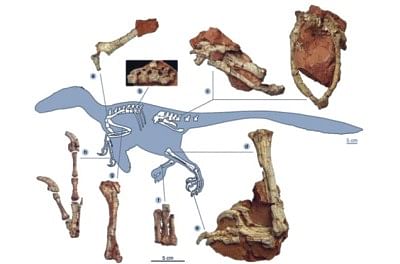Balaur bondoc: Dragon dinosaur

One of the questions that truly baffled paleontologists for generations is the ancient question: "What did the Late Cretaceous predatory dinosaurs in Europe look like"? And finally it seems, the recent discovery of the first reasonably complete skeleton of a meat-feasting dinosaur from the final 60 million years of the Age of Dinosaurs in Europe, is likely to shed answers to that long-standing question. Unearthed from a former floodplain near the city of Sebes, in central Rumania, the fossil in question is that of a stocky, two-clawed relative of Velociraptor, which paleontologists believe had twice as many giant stickle-like claws on its feet and happened to be more of a kick boxer than its notorious sprinter-like cousin. The partial skeleton of the predator (including leg, hip, vertebrae, arms, rib and tail bones), now called Balaur bondoc (Rumanian for Stocky Dragon) was unearthed by Geologist Matyas Vermir, a geologist at the Transylvanian Museum Society. It must be mentioned here that Balaur is a genus of dromaeosaurid theropod dinosaur. According to Dr. Mark Norell, chair of the Division of Paleontology, American Museum of Natural History, "We've all been waiting for something like this, and the wait has yielded an interesting surprise". It is believed that ancient predator was about 6/7 feet tall (1.8 to 2.1 meters high) and roamed between 72 million and 65 million years ago. And this was during the end of the Cretaceous period when much of the present-day Europe was covered in higher seas and when Romania was part of an island, archipelago. Based on the study of the fossils (details of which have been published in the August 30th edition of Proceeding of the National Academy of Sciences), the scientists believe that the creature had functional big toes with large claws. But the most interesting thing about this discovery is that this new species of carnivore had more than 20 features which strikingly make it unique since they are not shared by its nearest relatives. According to Dr. Norell, "It is one of the most unusual and strangest dinosaurs I've had the privilege of working on in my entire career".
For starter, paleontologists explain that in addition to a large claw on its second toe, Balaur had another large claw on its big toe that could be hyper-extended, presumably to slash its prey! It is also believed that its feet and legs were short and stocky with bones fused together and large muscle attachment areas on its pelvis, which indicates that the dinosaur primarily exercised its strength, not speed. Besides, its hands were atrophied and some of the hand bones were fused together, making it difficult for the creature to grasp its preys. And this strongly suggests that, along with its legs and foot traits, that Balaur relied on its hind limbs to grasp and over-power preys. These features are not quite common with other dromaeosaurs.
After studying its anatomy, experts believe that, the Jurassic predator may have hunted very differently from other predators of its kind. In fact, Balaur might have been a better hunter than the deadly Velociraptor, with its enlarged pelvic muscles and two large and lethal claws. As for the reason behind such distinctive features, scientists believe this is due to the "island effect". "Island effect" refers to the understanding that, island dwellers tend to be stranger and smaller than close relatives on continental land masses. This principle also suggest that, animals that are common to islands are often more primitive than their mainland relatives. Dr. Norell explains, "Because Balaur is related to dinosaurs like Velociraptor, it indicates that European island archipelago had a faunal connection with other parts of Europe, Asia and North America where this group of dinosaurs has also been found in similarly aged rocks. It also shows how pervasive island effects can be in producing truly unusual animals". Unusual or unique, whichever way one wants to put it, this research, funded by the Romanian National University Research Council, American Museum of Natural History and the U.S. National Science Foundation, clearly discovered that Balaur is indeed a new breed of predatory dinosaur. A very special one from anything paleontologists have ever known.

 For all latest news, follow The Daily Star's Google News channel.
For all latest news, follow The Daily Star's Google News channel. 



Comments